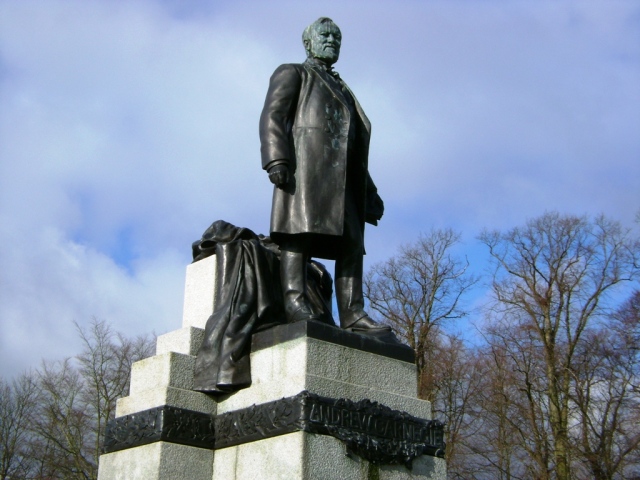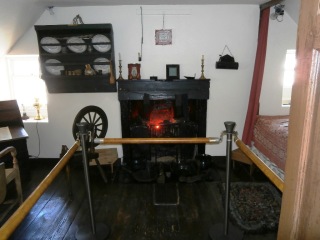
Andrew Carnegie statue erected in 1914 in Pittencrieff Park, Dunfermline
Photo credit: commons.wikimedia.org
While visiting Dunfermline we discovered the Andrew Carnegie Museum which was built around the humble cottage where Carnegie was born. The story of his youth makes his rise to become the richest man in the world* all the more intriguing.
In addition to telling the life story of Andrew Carnegie, the museum preserved the humble one room loft apartment where he was born and where his family cooked, ate and slept. Another family occupied the room across the hall. The first floor space was taken up by hand looms. Andrew’s mother, Margaret Carnegie, worked to hand weave towels and linens. Once textile factories mechanized the weaving process, the Carnegies fell on hard times.

Andrew Carnegie was born in this room, beds on the right, dining table to the left, no kitchen, no bathroom. Cooking was done at the fireplace.
Against the wishes of Andrew’s father, Margaret decided they should emigrate to Allegheny County, Pennsylvania where she had a sister. Andrew was 12 years old when they made the journey. Although education was not mandatory, Andrew had voluntarily attended school starting at the age of 8 and learned the basics. He put his sharp mind to use on his first job at age 15. He earned $1.20/week as a telegraph operator where he became invaluable by being able to translate Morse code messages by ear without having to write down the words.
Carnegie was hired as a personal secretary at $4.00/week at the age of 18 by Thomas A. Scott, owner of the Pennsylvania Railroad Company, one of the largest railroads in the country. Carnegie quickly rose to the role of superintendent of the Pittsburgh office. Carnegie’s relationship with Scott made possible an investment in Adams Express, which carried messages to corporate offices as they came in by telegraph. Margaret had to mortgage their house for $500 against its $700 value to make the payment. The investment paid off. Adams Express later grew to become American Express with Carnegie getting in on the ground floor.
The outbreak of the American Civil War called for rapid, large scale expansion of the railroads. Carnegie did not invest in railroads. He invested in the companies who supplied railcars, locomotives and parts to the railroads. Carnegie used money from his investments to open a steel plant using state-of-the-art technology to sell rails to the railroads. He also invested in iron mines, shipping and refineries. Eventually, Carnegie’s expanding steel empire threatened the future of other steel producers because he now owned the entire supply chain as well as the finished goods.

The library at Homestead, PA includes a swimming pool, a 1,000 seat theater and a bowling alley free for employees.
Photo credit: Explorepahistory.com
In order to stop him from overtaking the industry, the steel producers needed an investor who had the funds to buy him out. John Pierpont Morgan envisioned an integrated steel industry with efficiencies based on consolidation and minimizing waste. In 1901, Carnegie was 66 years old and ready to retire, so he accepted the largest corporate buyout in history. J.P. Morgan paid Carnegie $480 million ($13.2 billion today) and U. S. Steel was born. Carnegie spent the next twenty years of his life funding public works including the building of over 2,800 public libraries. He endowed the Universities of Scotland with $10 million including scholarships for boys who could otherwise not afford a university education. The Carnegie Trust continues to endow numerous universities.
As a pacifist, Carnegie had the Peace Palace built at The Hague in The Netherlands, which today houses the International Court of Justice (The World Court), and is still managed by the Carnegie Trust. The Trust also supported the Children’s Television Workshop. The Carnegie Museum displays Bert and Ernie puppets to commemorate the Trust’s support for the production of Sesame Street, now in its 44th year and broadcast in 140 countries.
Growing up in Dunfermline, Carnegie was excluded from entering the nearby private Pittencrieff Estate. In 1902, Carnegie purchased the 76 acre estate and gifted it to the people of Dunfermline. Today, as we depart Dunfermline, we pass Pittencrieff Park where now stands a statue of Andrew Carnegie, a self-made business mogul and philanthropist, a famous American and a favorite son of Scotland.





Smart man, that Carnegie.
Education was very important to Carnegie. He never had a formal education himself although he authored nine books. Every year his foundation provides grants for teachers and students.
Wow! This was fascinating Mike! Great post.
Thank you, Dawn. This was our final field trip before heading to Croatia. So glad you enjoyed it. – Mike
Can’t wait to hear more about Croatia!! Seems you’ve barely arrived in Scotland though. Enjoy your trip!
Hey Mike! What an interesting post. Carnegie certainly was a cool dude! Anywho – Paul and I are in Boston helping his parents get ready to put their house on the market. They’ve been in the house for 52 years, so it’s tough for them. Talk to you soon!! Celeste 🙂
You sound like you are busy. It is also busy here in Croatia. I have stories written I need to get posted, and we are so tired when we return after dark to our hotel. Florence and I look forward to sharing our stories with you soon. – Mike
I loved reading this post, And can’t help but wonder how Carnegie’s life would’ve turned out had he not found himself on the other side of the Atlantic. By the way, for anyone visiting Dunfermline I’d also strongly recommend a detour to Culross – it’s around 9 miles away, and is like stepping back 400 years in time. Truly sensational experience!
Thank you for the comments and the tip, Gavin. If we make it to Culross I will be sure to write something about it and credit you with the tip. 🙂 – Mike